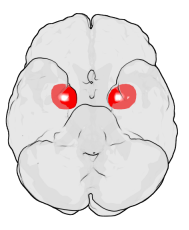Overcoming Fear
 We all fear things. Fear itself is a basic survival instinct. It’s a natural response to a specific stimulus used to recognize danger and initiate fight-or-flight responses. Many common fears include ghosts, cockroaches, spiders, snakes, heights, water, enclosed spaces, tunnels and bridges, needles, exams, clowns and public speaking. These fears can be innate (you don’t know why you
We all fear things. Fear itself is a basic survival instinct. It’s a natural response to a specific stimulus used to recognize danger and initiate fight-or-flight responses. Many common fears include ghosts, cockroaches, spiders, snakes, heights, water, enclosed spaces, tunnels and bridges, needles, exams, clowns and public speaking. These fears can be innate (you don’t know why you![]() ’re afraid of certain things) or they can be acquired by a frightening traumatic accident. For many people, their fears do not affect their quality of life. For some, however, fear can mean something completely different.
’re afraid of certain things) or they can be acquired by a frightening traumatic accident. For many people, their fears do not affect their quality of life. For some, however, fear can mean something completely different.
Post-traumatic stress disorder, or PTSD is a severe anxiety disorder that develops after an event that results in psychological trauma, overwhelming the individual’s ability to cope. PTSD causes flashbacks and nightmares, there is an avoidance of the offending stimuli, sleep disturbances (inability fall asleep or stay asleep), and anger. These affects are persistent for more than a month. PTSD can result as an affect from a very traumatic experience including rape, war, terrorist attacks, abuse, assaults, kidnapping, being a hostage, prisoner of war, or a severe automobile accident. It affects a person’s the quality of life. More than 7.7 million Americans suffer from the disorder. It has been predicted that 300,000 soldiers returning from the Middle East would experience PTSD.
 Researchers at the University of Iowa have located the part of the brain associated with experiencing fear, hoping to improve PTSD treatment options. This discovery came in the wake of a study of a patient with a rare condition that destroyed her amygdala. The amygdala is a small region of the brain associated with the processing and memory of emotional reactions. It is also the location of fear-learning and coordinates fight-or-flight responses. Because the patient did not have a functioning amygdala, she was unable to experience fear.
Researchers at the University of Iowa have located the part of the brain associated with experiencing fear, hoping to improve PTSD treatment options. This discovery came in the wake of a study of a patient with a rare condition that destroyed her amygdala. The amygdala is a small region of the brain associated with the processing and memory of emotional reactions. It is also the location of fear-learning and coordinates fight-or-flight responses. Because the patient did not have a functioning amygdala, she was unable to experience fear.
The researchers exposed the patient to normal fear-inducing stimuli including haunted houses, horror movies, snakes and spiders. The patient was unable to experience any fear. Any traumatic events leave no emotional imprints on her brain, no lasting effects. The part of our brains that warns us of danger is missing in the patient.
Researchers hope that this can lead to new or improved treatment options for PTSD. New treatments that target the amygdala in perhaps dampening the activity, might help those with the condition.
| Print article | This entry was posted by Jennifer Aiello on January 18, 2011 at 2:53 pm, and is filed under G2C Online. Follow any responses to this post through RSS 2.0. You can skip to the end and leave a response. Pinging is currently not allowed. |
